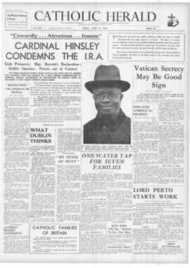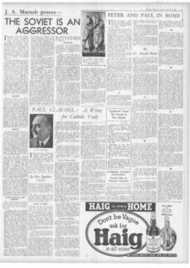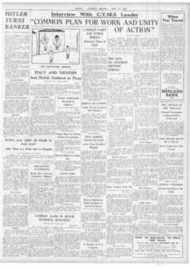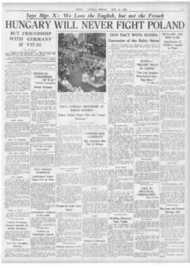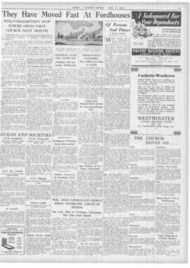Page 5, 30th June 1939
Page 5

Report an error
Noticed an error on this page?If you've noticed an error in this article please click here to report it.
Tags
Share
Related articles
Searching For Peter
Britain Fetes Fr. Dominic
Disastrous Prelude
Dateline Rome From Alan Mcelwain
St. Mark (died About 75 A.d.) April 25
PETER AND PAUL IN ROME
By Fr. Anselm Bolton
HE Bay of Naples — Appii Forum—the Three Taverns— we know the way along which St. Paul journeyed as a prisoner to Rome.
We can still follow the same wheel I racks along the Via Appia and look, as Paul must have looked, on the ;am arches of the aqueducts, striding across the quiet Campagna towards the imperial city ; and the melancholy grandeur of the tombs that lined the road in ever-increasing numbers as the city drew near, was no doubt very much the same for Paul as for the traveller to-day ; the ,;nnhurnt parasol pines were already sentinels there by the wayside, and there was the same wide sweep of the lonely Campagna plain.
But St. Paul, if he was like his historian in the Acts of the Apostles, had no eye for these things.
He was more interested in the little band of Christians that had gone out over forty miles to meet him ; some of them old friends, others that were new faces but just like old
friends, all of them speaking Greek, gathered together from many corners of the eastern Mediterranean. This little colony of Greek-speaking Christians was now to receive in its midst the great apostle for some two years.
Although chained to his guard the apostle seems to have been free to receive friends and even to live in his own house. We must always regret that the story of the Acts of the Apostles ends with but a brief account of St. Paul's stay in Rome. We must of course presume that Paul was freed after two years, seeing that his historian gives the length of his imprisonment and says nothing about his death. There is so much more that we should like to know, but which the Acts of the Apostles did not think it needful for us to know.
Yet some glimpses of St. Paul in Rome may be found in the epistles written by him as a captive—to the Ephesians, to the Colossians, to his beloved Philippians, and to his friend, Philemon. We can gather from casual references made that it was largely through the generosity of the apostle's affectionate disciples at Philippi that provision was made for St. Paul's little household in Rome.
We read that Luke and Aristarchus, who had made the long journey to Rome with him, were continually by his side; Luke, " the dear physician," being a man of culture, was of great service as a secretary, and Aristarchus, having once been manhandled by a. mob in Ephesus, was no doubt a fearless and cheerful companion.
From Paul a prisoner messengers went backwards and forwards, keeping the apostle in touch with his congregations in many parts of the world. Timothy, for many years the most active and
most trusted of Paul's helpers, to Rome for a time, afterwards probably
returning to Greece and Macedonia. Tychicus, himself a native of Asia Minor and formerly a companion on St. Paul's missionary journeys, went from Rome with the apostle's message for the people of Asia Minor. Mark was with Paul for a time and perhaps his presence in Rome indicates that Peter was there at the same time. Surely the most interesting arrival was Onesimus, the runaway slave from the household of Paul's friend and convert at Colossae, Philemon.
How the truant slave came into Paul's circle we shall never know, but we can imagine that a lad from the provinces arriving with some stolen money in the capital would probably drift into the Greek colony from Asia Minor where he would be most at home. It seems probable that St. Paul would be living with the same colony, to which after all he belonged as a native of Tarsus. The runaway slave was converted and baptised by the apostle; he found a ternporary home in Paul's house and made himself so useful that it was with regret that Paul sent him back to his master; in sending him away, the apostle felt that it was like parting with a son.
We do not know with any certainty how St. Paul fared after his two years in Rome. Clement of Rome, writing only thirty years afterwards and therefore with knowledge of facts that were so recent, says that St. Paul before his death "reached the farthest bounds of the West," which is generally understood to mean that St. Paul reached Spain.
Then from the apostle's second letter to Timothy, written during a second captivity in Rome, we must suppose that the apostle had also revisited the churches of Asia Minor and Greece, since he mentions that he forgot his cloak at Troas, and left one of his companions in Corinth. A certain loneliness and weariness of spirit shows through in this letter: all have left him except Luke; at his first judicial questioning no man stood with him, but the Lord supported him and delivered him from the lion's mouth. Yet now Paul is beginning to look for a different deliverance: " The Lord hath delivered me fram every evil work and will preserve me unto his heavenly kingdom; to whom be glory for ever and ever." Those are the last words written by the Apostle of the Gentiles.
•
By what route and at what time did the Apostle Peter go to Rome? We cannot say for certain. Perhaps like his successor in the see of Antioch, the great bishop and martyr, Ignatius, he arrived by sea on the northern bank of the Tiber at Portus, the port of Rome. The exact period of St. Peter's ministry in Rome has been variously calculated by Church historians from the time of Eusebius in the fourth century. The earliest reference we know to St. Peter's death is in the letter of Clement of Rome, already mentioned, Belonging to a generation that had known Peter and Paul, Clement speaks of the persecution of Nero, and seems to associate it in his mind with Peter's death: " There was Peter, who by reason of unrighteous envy endured not one nor two but many trials, and so, having borne witness (in Greek, having been a martyr or witness) he passed to his appointed place of glory." The writer goes on to describe the end of St. Paul: " Amid envy and strife, Paul pointed out the way to the prize of patient endurance . . Unto these men of holy life was gathered a vast multitude of the elect, who, through many indignities and tortures, endured envy and set a fair example among us." Clement does not mention Nero by name, nor does he make any explicit reference to the manner of the apostle's death, because it was extremely dangerous at his time to do so. Did not Peter write in his first epistle: " The Church that is in Babylon saluteth you," obviously referring to Rome, the new and greater Babylon that persecuted the just of God? Clement might well use veiled language at a time when the Roman world had just endured the violent persecution of the Emperor Domitian.
0
Throughout the second century one important witness after another has left testimony that has survived to this day as to the presence of Peter and Paul in Rome: St. Ignatius of Antioch, St. Denis of Corinth, St. Irenaeus of Lyons, and finally the priest Caius of Rome, whose words are as true to-day as when he wrote them: " For if you will go to the Vatican or to the Ostian way, you will find the trophies of those who laid the foundations of this Church," The present splendid basilicas of the Vatican and the Ostian way must far outshine the trophies first set up by the Church that had not yet emerged from the Catacombs. It is indeed a remarkable tribute to the continuity and lasting quality of the Church's tradition that, in spite of wars, persecutions and disorders, in spite of the tremendous ravages and upheavals during nineteen hundred years of change, the bodies of the Roman Apostles are still to be found where pious hands first laid them to rest.
Why St. Peter on the Vatican hill and St. Paul at the second milestone on the Ostian way, heading for the sea? The most likely answer is that their monuments stand close to where they were first buried. In the case of the basilica of St. Paul, it is still possible to see in some places around the church extensive traces of an old pagan burial ground, or rather, columbarium. It is probable that the body of St. Paul was laid to rest there in the funeral plot of some devout Christian. Tradition says that Peter was buried on the right bank of the Tiber, somewhere near the Vatican hill among the tombs along the Via Aurelia, and not far from the circus of Nero. On this spot, in 323, the Emperor Constantine erected his magnificent basilica, surrounding the tomb with huge plates of brass, and laying over it a huge cross of gold. Only once since then has this been brought to light again, at the time of the rebuilding of St. Peter's in the sixteenth century. Similarly, very few have been privileged to see the black marble slab that lies under the high altar of St. Paul's and immediately over the remains of the apostle; it bears the severe and simple inscription: Paulo Apostolo Martyri, To Paul, Apostle and Martyr.
The Vatican and the Ostian way have housed the relics of the apostles except for a short period. The researches of scholars during the last fifty years, and excavations in the catacombs below the ancient Church of St. Sebastian on the Appian way, have revealed the fact that, during the persecution of the Emperor Valerian, in 258, the bodies of the apostles were hidderl underground below this church.
That the relics were hidden here for a time is the only satisfactory explanation of the invocations to Peter and Paul lately discovered in the subterranean vault at St. Sebastian's. Moreover, it is the only satisfactory explanation of a note found in Rome's earliest known calendar of feasts, which belongs to the fourth century. In this calendar we read under the heading June 29: Feast of the holy apostles, Peter and Paul: Peter in the Vatican on the Aurelian way; Paul on the Ostlan way; both in the Catacombs. Thus the great feast of the end of June that unites both apostles in one solemn commemoration is thought to date from the time when their bodies were brought together in the Catacombs, namely, on June 29, in the year 258.
Although at the end of June we celebrate the glorious memory of the apostles' martyrdom, it seems likely that the actual date chosen for the feast is due to their relics being translated to the Catacombs and brought together for the first time. It is thought that the bodies of the apostles remained in the Catacombs by the third milestone on the Appian way from the year 258 to early in the next century.
Petre et Pante orate pro nobis—we see written on the walls where the bodies of the apostles lay hidden, and where faithful men visited them in secret. When we address our prayers to these glorious apostles what need have we to add any titles of honour or veneration to their names? Peter and Paul are names that of themselves alone can invoke the love, devotion and enthusiasm of Christian hearts. These names represent for us what is of the highest and noblest in the story of Christian achievement; they are the first victorious challenge to the pagan might of Rome's empire, and they stand among the most glorious trophies of Christ's triumph. Let us copy the simplicity and the affectionate familiarity of those early pilgrims, who scratched their petitions on the walls of the Catacombs where the apostles lay buried: Peter and Paul
pray for us. There is no need for greater eloquence.
blog comments powered by Disqus


